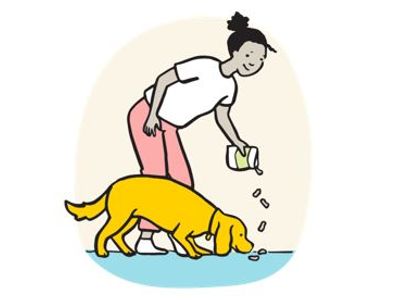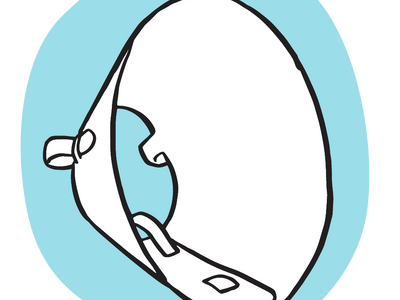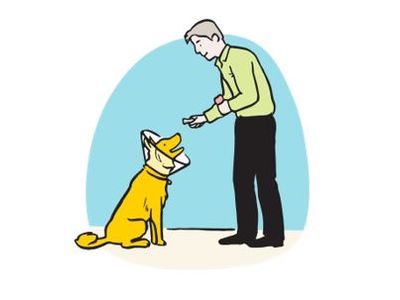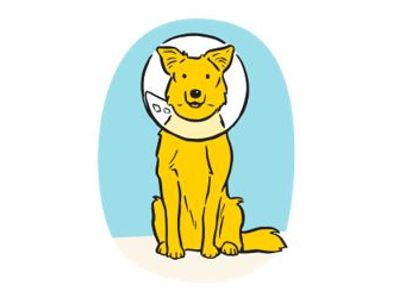How to introduce a pet cone
Introduce cones and collars in a positive way and help your dog understand that they're nothing to worry about.
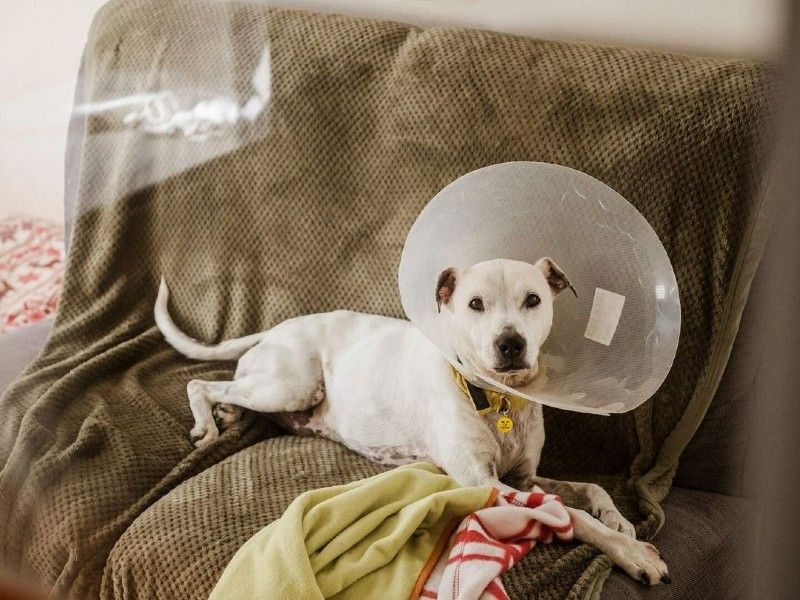
Elizabethan collars – also known as dog cones, buster collars, lampshades or donuts – sit around a dog’s neck to stop them from chewing, licking, nibbling, or scratching wounds while they heal. Introduce them in a positive way and help your dog understand that they're nothing to worry about.
They are made from soft plastic, reinforced fabric, or inflatable tubing. They need to be large enough to work while being as comfortable as possible. Talk to your vet about which type is best suitable for your dog.
Pet cones limit movement, restrict vision and affect the way smells reach the nose. They are only worn for short periods, but the inability to do normal things could make dogs feel frustrated or worried. We have no way of explaining to our dogs that the cone is to help them and won’t be there forever. You can teach your dog that a cone isn’t anything to worry about using the steps below. Then they will hopefully be prepared to wear one, should they ever need to.
Top tips for training your dog to wear a cone
- Pet cones can be fiddly, so practise first without your dog. This will help you learn how to make the collar correctly, and to feel confident using one, which can help your dog to feel confident too. Ask your vet if you’re not sure how to fit it.
- It can help to start with a larger collar, so your dog can place their head in and out with ease.
- Keep sessions short. It can be tempting to rush ahead, especially if your dog appears to be doing well, but taking things gradually means you can both feel confident all the way.
- Repeat each stage several times so your dog becomes familiar and comfortable with what you’re doing. Keep telling your dog how well they’re doing and rewarding them. If either of you is struggling, go back to an earlier stage (even the beginning) and practise for a little bit longer before moving on again.
- Start when your dog is happy and relaxed.
- Watch your dog as you go. Stop right away if you see any change in their body language which suggests that they are worried or uncomfortable. An understanding of a dog’s body language is essential in helping you and your dog work together.
A step-by-step guide for teaching your dog to wear a cone
To get started, you'll need a handful of extra tasty treats and your desired cone.
Desensitize your dog
Place the collar on the floor and scatter some treats around it for your dog to find and enjoy. This is so they can get used to seeing, or even touching, the collar and associate it with yummy treats.
Positive reinforcement
Place the collar with the opening at the top, like a bowl. Scatter some treats inside the collar, so your dog has to put their head through the opening to eat them. It’s safer for your dog to learn this way as they can easily remove their head if they suddenly feel …
Go at your dogs pace
Hold the collar slightly tilted from the ground, so your dog has to push their head through it to reach the treats, which you might now need to feed by hand.
Let your dog remove their head from the collar then throw another treat out for them to chase and enjoy. …
Encourage your dog
Lift the collar up. Your dog should pop their head through straight away if they’re expecting treats. If they back away or become excited, then go back a step for a little bit longer to build up their confidence. Treat them once their head is through, then remove the ��…
Move with the cone
Slowly begin to move while holding the collar around your dog’s neck. Be ready to feed treats as soon as your dog pops their head through and keeps it there, then every few paces.
This teaches your dog that moving with the collar around their face isn’t anything to …
Cone master
Scatter some treats onto the floor and loosely fasten the collar around your dog’s neck while they’re eating them. Let go of the collar and continue to feed your dog while they’re wearing it.
Encourage them to move while wearing it by feeding them by hand every …
Helping your dog while they’re wearing a buster collar
If you know your dog is going to have an operation and might need to wear a buster collar afterwards, prepare your home in advance to help them move around easily and safely.
- Prop doorways open and tidy walkways to help your dog to move comfortably around the home without bumping into things.
- Block access to stairs by closing doors or using a child-gate. However, be aware this might upset your dog if they’re used to going everywhere, so be prepared to help your dog settle.
- Remove anything valuable to avoid accidental breakage as your dog might not be able to gauge how wide the collar is to begin with.
- Watch your dog eating and drinking, as it might be difficult with the collar on. Even a quick chew of a wound could cause problems, so if you remove the collar for mealtimes, always supervise and replace it straight away afterwards. Raise food and water bowls onto a slightly higher, secure surface to make it easier for your dog to reach them comfortably whilst wearing the collar.
- Your dog can sleep with the cone on, just keep an eye on them in case they need help whilst unsupervised.
- Keep your dog on a lead when outside with a cone. If necessary, keep to toilet walks. Your vet will be able to advise you on how much and what type of exercise your dog needs whilst in recovery.
- Healing wounds can be itchy, so keep your dog occupied if they need a distraction. Use long-lasting food-releasing toys and give them lots of company and attention.
If your dog is still fearful or displaying uncomfortable body language with a cone, speak to your vet with any concerns you might have and they will be able to advise you further.
